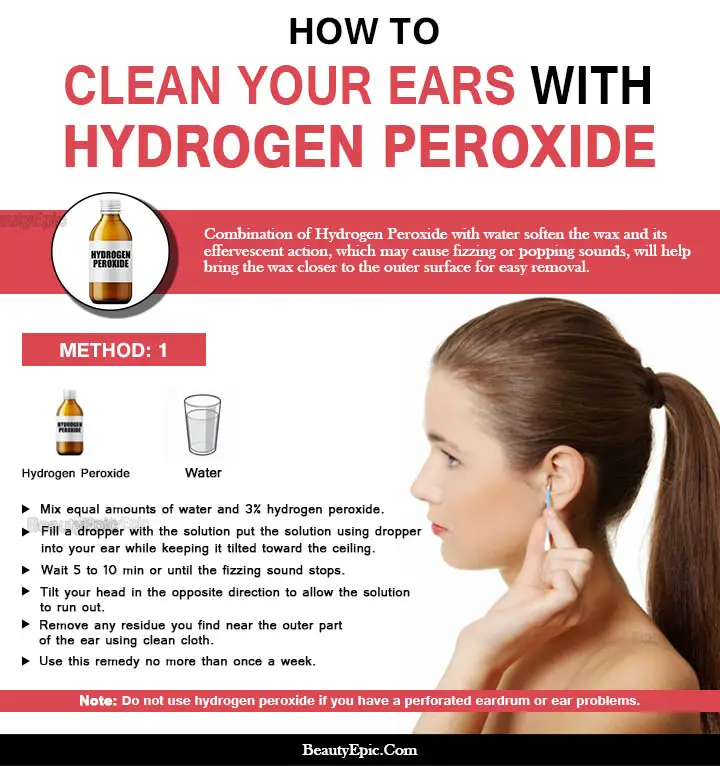

- Cleaning ears with hydrogen peroxide skin#
- Cleaning ears with hydrogen peroxide full#
- Cleaning ears with hydrogen peroxide professional#
They have no proven benefit in the removal of earwax and can cause serious injury. The force of the water injures the ear canal and ruptures the eardrum. Do not use a dental irrigation device, such as a Water Pik, to remove earwax.Do not use cotton swabs, bobby pins, or other objects to clean the ear.Cool or hot fluids in the ear can cause dizziness. Make sure the flushing solution is body temperature.


Hold the dryer several centimetres (inches) from your ear. Dry your ear thoroughly with a hair dryer set on low. Direct the water into the ear, then tip your head to let the earwax drain out.
Cleaning ears with hydrogen peroxide professional#
Professional help may be needed to remove tightly packed earwax.ĭo not try to remove earwax if you have ear pain or a discharge that looks different than earwax, if you think you have a ruptured eardrum, if you have had ear surgery, or if you have tubes in your ears. Most earwax problems can be handled with home treatment. Poking at the wax with cotton swabs, your fingers, or other objects usually only further compacts the wax against the eardrum.
Cleaning ears with hydrogen peroxide full#
Impacted earwax may cause some hearing loss or other problems, such as ringing in the ears (tinnitus), a full feeling in the ears, or vertigo. The ear canal may become blocked (impacted) when attempts to clean the ear with cotton swabs, bobby pins, or a finger push wax deeply into the ear canal. Children produce a lot of earwax, which tapers off as they grow older.Įarwax is normally produced only in the outer half of the ear canal and will not become deeply impacted unless it is pushed in. In children, earwax is usually softer and lighter than the earwax produced by adults.
Cleaning ears with hydrogen peroxide skin#
As the skin of the ear canal sheds, the wax is carried to the outer part of the ear canal and drains from the ear by itself.Įarwax ranges in colour from light to dark brown or orange. Normally, earwax is a self-draining liquid that does not cause problems. The ear canals are self-cleaning.Įarwax helps filter dust, keeps the ears clean, and protects the ear canal from infection. It is a mixture of skin, sweat, hair, and debris (such as shampoo and dirt) held together with a fluid secreted by glands inside the ear canal (ceruminous glands). In some rare cases, however, you may be referred to a provider with special training in ear disorders (ear, nose and throat specialist).Īs you prepare for your appointment, it's a good idea to write a list of questions.Earwax is a naturally produced substance that protects the ear canal. You're likely to start by seeing your health care provider. Talk to your health care provider before trying any alternative remedies for removing earwax. There is no data that shows they are safe for earwax removal, or that they work. It may also burn or damage the ear.Įssential oils - such as tea tree oil or garlic oil - are also not a proven treatment for earwax blockage. Research has found that ear candling doesn't work. However, ear candling isn't a recommended treatment for earwax blockage. The idea is that the heat from the flame will create a vacuum seal that draws wax up and out of the ear. Ear candling involves lighting one end of a hollow, cone-shaped candle and placing the other unlit end into the ear. Some people try to remove earwax themselves using a technique called ear candling (ear coning). You may push the wax farther into your ear and cause serious damage to the lining of your ear canal or eardrum. Never attempt to dig out excessive or hardened earwax with available items, such as a paper clip, a cotton swab or a hairpin. People shouldn't use ear drops if they have an ear infection unless it's recommended by a health care provider. If you're prone to earwax blockage, your health care provider can show you safe ways to reduce wax buildup at home, such as using ear drops or other earwax-softening agents. The safest way to clean your ears if you have excess wax is to see your health care provider.

This means they may not work and may be dangerous. But most of these treatments - such as irrigation or ear vacuum kits - aren't well studied. You can get many ear cleaning home remedies over the counter.


 0 kommentar(er)
0 kommentar(er)
